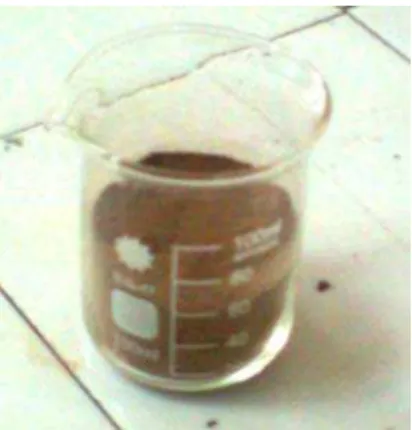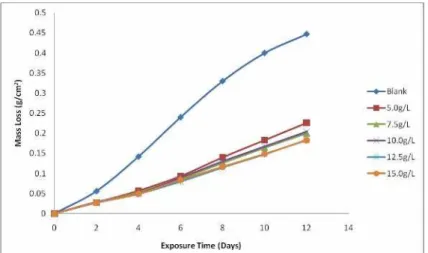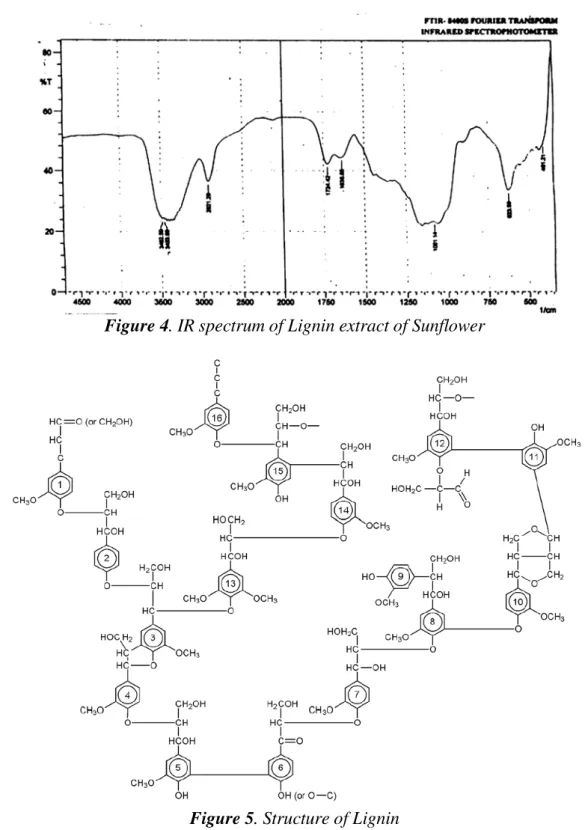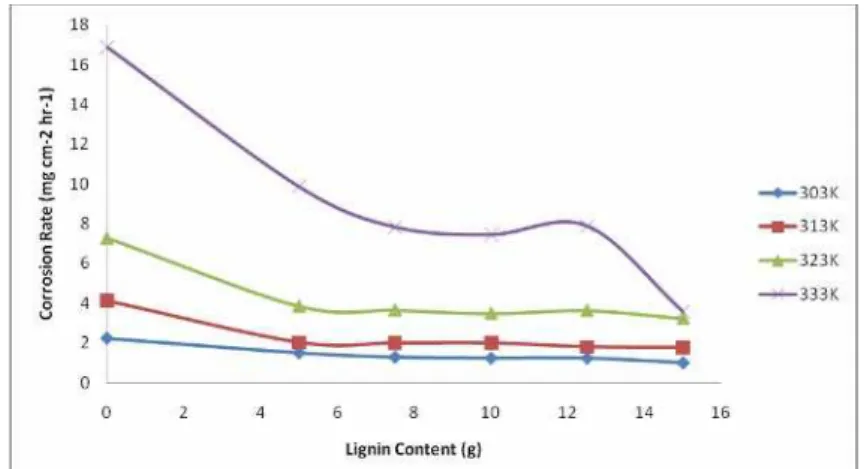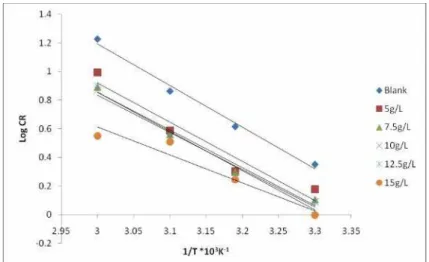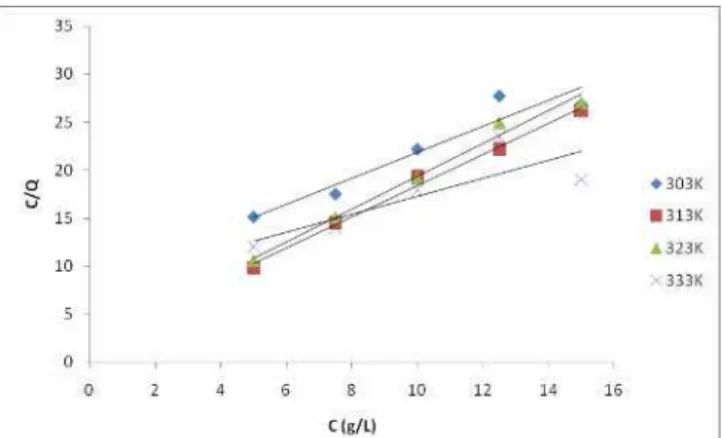Corrosion Inhibition Performance of Lignin Extract of Sun Flower
(
Tithonia Diversifolia
) on Medium Carbon Low Alloy Steel Immersed in
H
2SO
4Solution
Kenneth Kanayo ALANEME* and Sunday Joseph OLUSEGUN
Department of Metallurgical and Materials Engineering, Federal University of Technology, Akure, PMB 704, Nigeria
E-mail(*): kalanemek@yahoo.co.uk
Abstract
The inhibition potentials of lignin extract of sun flower was investigated by
evaluating the corrosion behaviour of medium carbon low alloy steel
immersed in 1M H2SO4 solution containing varied concentration of the
extract. Mass loss, corrosion rate, and adsorption characterization were
utilized to evaluate the corrosion inhibition and adsorption properties of the
extract. The results revealed that the lignin extract is an efficient inhibitor of
corrosion in mild steel immersed in 1M H2SO4. The corrosion rates were
observed to decrease with increase in concentration of lignin extract but
increase with temperature. The activation energies and the negative free
energy of adsorption obtained from the adsorption studies indicate that the
lignin extract is physically adsorbed on the surface of the steel and that the
adsorption is strong, spontaneous and fit excellently with the assumptions of
the Langmuir adsorption isotherm.
Keywords
Lignin; Corrosion inhibition; Mass loss; Low alloy steel; Adsorption; H2SO4;
Introduction
The corrosion of engineering materials is known to lower performance efficiency and
lead to reduced service life, in severe cases it could serve as a precursor to catastrophic
failures which result in grave losses [1]. A lot of technological efforts have been put into
developing strategies of mitigating corrosion through materials selection, changes in design
philosophies and the adoption of varied prevention techniques. The use of inhibitors has been
well documented as an effective method of protecting metallic materials from corrosion [2].
Many industrial processes have put to use inorganic inhibitors for corrosion protection but as
a result of cost and toxicity, attention is currently shifted towards the use of more eco-friendly
inhibitors [3-4]. Organic substances (plant based) containing functional groups with oxygen,
nitrogen and /or sulphur atoms in a conjugate system have been reported to exhibit good
inhibiting properties [4-7]. This has made plant extracts an important choice for
environmentally friendly, readily available and renewable source for wide range of inhibitors
referred to as green inhibitors [5]. Some of the advantages of green inhibitors are low cost of
processing, biodegradability, and absence of heavy metals or other toxic compounds which
pose great hazard to the environment [8]. A number of successful studies on the use of plant
extract as corrosion inhibitors have been investigated and reported by several authors [9-16].
There are however concerns on the sustainability of the use of some of these green inhibitors
when commercial scale processing is of interest, since some of the extracts can only be
derived from specific plants which are still utilized for so many other applications; coupled
with the fact that some of these plants are seasonal. These factors place limits to the extent
most green inhibitors could be applied commercially. Lignin however will be an exception –
it is a complex chemical compound most commonly derived from wood and an integral part
of secondary cell walls of all plants [17]. Since Lignin is an integral part of all plants, it does
not have the disadvantage of seasonal or location specific availability, which is common to
organic inhibitors specific to certain plants. Lignin and its derivatives have been utilized in
many applications such as resin synthesis [18], dispersants, emulsifiers, adhesives and ion
exchangers [19]. But little attention has been given to its potential corrosion inhibitive
properties. Its consideration as a potential inhibitor is informed by its IR spectrum which
shows that it contains functional groups such as OH- which is known to have inhibitive
of lignin extract derived from sunflower on medium carbon low alloy steel immersed in
H2SO4 solution.
Material and Method
Materials Preparation
Medium carbon low alloy steel was utilized as test material for this research. The
chemical composition of the steel was determined using a spark spectrometric analyzer; and
the composition is as presented in Table 1. The medium carbon steel was cut to dimensions of
20mm length × 10mm diameter for use as test coupons. Surface preparation of the coupons
was performed following standard procedures.
Table 1. Chemical composition of the Medium Carbon Low Alloy Steel
Elements C Si S P Mn Ni Cr Mo V Cu W Fe
Wt % 0.337 0.163 0.0464 0.053 0.813 0.102 0.178 0.018 0.0046 0.36 0.0021 balance
Extraction of Lignin
Sun flower which is readily available in the Akure Metropolis was utilized as the
source of Lignin. The stems of the plant were cut into small pieces and sun dried. The dried
samples were then pulverized into powder using a grinding machine, and sieved using 850µm
mesh screen sieve. 150g of the 850µm mesh screen sieved biomass was weighed and added to
1500ml of prepared 15% NaOH solution in a plastic container.
Figure 1. Lignin extract derived from the processing of the sunflower
The mixture was immersed in a water bath set at 80oC for 2 hours and stirring of the
cool overnight; after which it was filtered and the pH of the filtrate (black liquor) adjusted to
2 by using 40% H2SO4. The precipitate formed (Lignin) was filtered and dried in an oven at
60oC. Figure 1 shows representative samples of the Lignin obtained.
Immersion Test
The polished and pre-weighed medium carbon low alloy steel coupons were immersed
in 100ml of 1M H2SO4 solutions of the respective inhibitor/blank solutions maintained at 303,
313, 323, and 333K in a thermostated bath for 6 hours. After which the coupons were
removed washed, cleaned and weighed. Another set of experiment was carried out at room
temperature for various concentration of lignin in 1M H2SO4 for 12 days. The coupons
immersed in these solutions were weighed at two day intervals. Mass loss and corrosion rate
measurements were utilized to evaluate the corrosion behaviour of the test samples. The
inhibition efficiency (%) was calculated using the relationship: I.E. = 100·(1-C.Rinh/C.Rblank),
where C.Rinh and C.Rblank correspond to the corrosion rates in the presence and absence of
inhibitor respectively.
Characterization and Adsorption Studies
Characterization of the extracted lignin was carried out by FT-IR studies. FT-IR
(FTIR-8400S) spectroscopy was employed to determine the type of functional groups present
in the lignin responsible for its inhibitive properties.
Results and Discussion
Mass Loss Method
Figure 2 and 3 presents the mass loss and corrosion rate plots for the medium carbon
low alloy steel samples immersed in 1M H2SO4 with varied concentrations of the lignin
extract. It is observed that there is a significant reduction in the mass loss of the steel samples
with the addition of the lignin extract in comparison with the sample in which no lignin was
added. This clearly indicates that corrosion inhibition of medium carbon low alloy steel
immersed in H2SO4 solution is improved with the addition of lignin. Furthermore, it is
15g/L) resulted in a moderate decrease in mass loss (from 0.226g/cm2 for 5g/L to 0.183g/cm2
for 15g/L).
Figure 2. Variation of Mass loss with varied concentrations of Lignin in 1M H2SO4 Solution
Figure 3. Variation of Corrosion rate with varied concentrations of Lignin in 1M H2SO4 Solution
This is an indication that the mass loss is sensitive to the concentration of the lignin
extract. This trend is most likely due to the fact that adsorption and surface coverage of the
steel increases with concentration of the inhibitor [10]. Thus the surface of the steel is more
effectively separated from the medium [20]. The inhibitive effect of the lignin extract is
attributed to the presence of some functional groups in the extract as revealed by the Infrared
Spectrophotometer result (Figure 4).
It is observed that the extract has OH- among others which have been reported to
contribute to inhibition. The structure of the lignin extract as presented in Figure 5 contains
Figure 4. IR spectrum of Lignin extract of Sunflower
Figure 5. Structure of Lignin
The observed trends are well supported by the corrosion rate plots (Figure 3) which
show that the corrosion rate reduces sharply after the 4th day of immersion for the samples
containing the lignin extract and a gradually reducing rate of corrosion is maintained with
further exposure time. This suggests that the adsorption of the lignin was stable for the entire
The Effect of Temperature
The stability and mechanism of adsorption of the extract (lignin) on the medium
carbon low alloy steel surface was studied by evaluating the variation of corrosion rate and
inhibition efficiency with temperature (303K-333K) (Figures 6-7). It is observed from figure
6 that at any of the temperatures, corrosion rate decreases with increase in lignin extract
concentration while the corrosion rates increases with increase in temperature. This trend is
consistent with the observations of Okafor et al. [21] who reported that the tendency for
partial desorption of the inhibitor from the metal surface and the metal dissolution increases
with temperature. The variation in inhibition efficiency (Figure 7) did not follow a consistent
trend like in the case of the corrosion rates. However, inhibition efficiency of the lignin
extract ranged between 55.5% - 78.8% for different temperatures.
Figure 6. Variation of Corrosion rate with temperature
Kinetic/Thermodynamics and Adsorption Studies
The adsorption mechanism of organic inhibitors on metal surfaces can be by physical
adsorption and chemical adsorption; and is influenced by factors such as nature of the charge
of the metal, the chemical structure of the inhibitor, pH, the type of electrolyte and
temperature [22]. Thus in order to predict the inhibition mechanism, the activation energy for
the corrosion reaction in the absence and presence of various concentrations of lignin at
temperatures ranging between 303K-333K was evaluated using the relationship:
Log(CR) = Log(A) - Ea/(2.303·R·T)
where CR is the corrosion rate, Ea is the apparent activation energy, R is the molar gas
constant, T is the absolute temperature and A is the frequency factor. The activation energies
were obtained from the slope of the Log CR Vs. 1/T plots for the medium carbon low alloy
steel in the absence and presence of lignin as presented in Figure 8.
The estimated activation energies (Ea) from the plots are presented in Table 2. It is
observed that the Ea values ranged from 37.46 KJ/mol to 55.6 KJ/mol for all concentrations of
lignin. Ebenso et al. [8] reported that values of Ea < 80KJ is indicative of physical adsorption
while Ea > 80KJ is indicative of chemical adsorption. Thus the activation energy values
support the fact that the lignin extract was physically adsorbed on the medium carbon low
alloy steel surface.
Figure 8. Arrhenius plot for medium carbon low alloy steel corrosion in 1 M H2SO4 in the absence and presence of lignin extract
Table 2. Thermodynamics and activation parameters for mild steel in presence of lignin extract in 1 M H2SO4
-∆G(kJ/mol) Acid medium Inhibitor
Conc.(g/l) Ea
kJ/mol 303K 313K 323K 333K -∆S kJ/mol
+∆H kJ/mol
Blank 55.60 - - - -
5.0 52.53 13.80 30.02 26.49 21.91 0.20792 43.06
7.5 50.54 13.98 20.60 19.71 23.70 0.28267 70.39
10.0 49.95 11.48 15.45 16.22 19.47 0.24735 63.00
12.5 52.44 9.185 14.89 11.96 14.02 0.11583 24.32
1 M H2SO4
15.0 37.46 11.78 12.91 12.42 38.21 0.78849 231.91
The values obtained are presented in Table 2. It is observed that the values of the
∆G°ads are negative in all cases, indicating that the lignin extract is strongly adsorbed on the
mild steel surface [23]. Generally, values of ∆G°ads up to -20kJ/mol are consistent with
electrostatic interaction between charged molecules and a charged metal (which indicates
physisorption) while those more negative than -40kJ/mol involve charge sharing or transfer
from the inhibitor molecules to the metal surface to form a co-ordinate type of bond (which
indicates chemisorptions) [24].
To further elucidate the mechanism of corrosion adsorption, the adsorption isotherms
which provides information on the variation of adsorption with the concentration of the
adsorbent (lignin extract in this case) in bulk solution at constant temperature was plotted
(Figure 9). The adsorption isotherms are very important in determining the mechanism of
organo-electrochemical reactions [25]. The experimental data obtained were best fitted with
the Langmuir adsorption isotherm which is described by the equation:
C/θ = 1/Kads + C,
where (C/θ) is the ratio of inhibitor concentration to surface coverage, Kads the adsorption
equilibrium constant.
The slopes obtained from the plots were observed to be close to unity; and the
isotherm was observed to be best fitted at 313K and 323K where the correlation coefficients
were greater than 0.995. This suggests that the adsorption of lignin on the steel is a monolayer
adsorption and that there is no interaction between lignin and the medium carbon low alloy
steel [26].
Conclusions
From the results obtained from this research investigation, the following conclusions can
be drawn:
÷ Lignin extract from sun flower was found to be an efficient inhibitor for the corrosion of
medium carbon low alloy steel in 1M H2SO4.
÷ The corrosion rates were observed to decrease with increase in concentration of lignin
extract but increase with temperature.
÷ The activation energies and the negative free energy of adsorption obtained indicate that the lignin extract is physically adsorbed on the surface of the steel and that the adsorption
is strong and spontaneous.
÷ The lignin extract was proved to be an effective eco friendly and low cost inhibitor.
References
1. Alaneme K.K., Corrosion Behaviour of heat-treated Al-6063/ SiCp Composites immersed
in 5wt% NaCl Solution, Leonardo Journal of Science,2011, 18, p. 55-64.
2. Tosun A., Ergun M., Protection of Corrosion of Carbon Steel by Inhibitors in Chloride
Containing Solutions, G. U. Journal of Science, 2006, 19(3), 149-154.
3. Orubite K.O., Oforka N.C., Inhibition of the corrosion of mild steel in hydrochloric acid
solutions by the extracts of leaves of Nypa frutican Wurmb. Materials Letters, 2004, 58, p.
1768-1772.
4. El-Etre A.Y., Abdallah M., El-Tantawy Z.E., Corrosion inhibition of some metals using
5. Raja P.B., Natural Products as Green Corrosion Inhibitor for Metals in Corrosive Media,
LAP Lambert Academic Publishing, 2010.
6. Chauhan L.R., Gunasekaran G., Corrosion inhibition of mild steel by plant extract in
dilute HCl medium, Corrosion Science, 2007, 49, p. 1143-1161.
7. El-Etre A.Y., Khillah extract as inhibitor for acid corrosion of SX 316 steel, Applied
surface Science, 2006, 252, p. 8521-8525.
8. Ebenso E.E., Eddy N.O., Odiongenyi, A.O., Corrosion Inhibitive properties and
adsorption behaviour of ethanol extract of piper guinensis as green corrosion inhibitor
for mild steel in H2SO4, African Journal of Pure and Applied Chemistry, 2008, 29(11), p.
107-115.
9. Oguzie E.E., Evaluation of the Inhibitive Effect of some Plant Extracts on the Acid
Corrosion of Mild Steel, Corrosion Science, 2008, 50(11), p. 2993-2998.
10.Vijayalakshmi P.R., Rajalakshmi R., Subhashini S., Corrosion Inhibition of Aqueous
Extract of Cocos nucifera - Coconut Palm - Petiole Extract from Destructive Distillation
for the Corrosion of Mild Steel in Acidic Medium, Portugaliae Electrochimica Acta, 2011,
29(1), p. 9-21.
11.Lebrini M., Robert F., Roos C., Alkaloids Extract from Palicourea guianensis Plant as
Corrosion Inhibitor for C38 Steel in 1 M Hydrochloric Acid Medium, Int. J. Electrochem.
Sci., 2011, 6, p. 847-859.
12.Loto C.A., Loto R.T., Popoola A.P.I., Effect of neem leaf (Azadirachita indica) extract on
the corrosion inhibition of mild steel in dilute acids, International Journal of the Physical
Sciences, 2011, 6(9), p. 2249-2257.
13.Saratha R., Vasudha V.G., Emblica Officinalis (Indian Gooseberry) Leaves Extract as
Corrosion Inhibitor for Mild Steel in 1N HCl Medium, E-Journal of Chemistry, 2010,
7(3), p. 677-684.
14.Adeyemi O.O., Olubomehin O.O., Investigation of Anthocleista djalonensis Stem Bark
Extract as Corrosion Inhibitor for Aluminum. The Pacific Journal of Science and
Technology, 2010, 11(2), p. 455-462.
15.James A.O., Akaranta O., Inhibition of Corrosion of Zinc in Hydrochloric Acid Solution
16.Nnanna L.A., Onwuagba B.N., Mejeha I.M., Okeoma K.B., Inhibition effects of some
plant extracts on the acid corrosion of aluminium alloy, African Journal of Pure and
Applied Chemistry, 2010, 4(1), p. 11-16.
17.Lebo S.E., Gargulak J.D., McNally T.J., ‘Lignin’ Kirk Othmer Encyclopedia of Chemical
Technology, John Wiley, 2001.
18.Nada A.M, Youssef M., El-Shafie kh, Salah A., Lignin from Waste Black Liquor, Pigment
and Resin Technology, 1999, 28, p. 143.
19.Lehrfeld J., Coversion of Agricultural Residues into Cation Exchange Materials, Journal
of Applied Polymer Science, 1996, 61, p. 2099-2105.
20.Al-Andis N., Khamis E., Al-Mayouf A., Aboul-Enein H., Corros. Prev. Cont., 1995, 42, p.
13.
21.Okafor P.C., Ebenso E.E., Ekpe U.J., Azadirachta Indica Extracts as Corrosion Inhibitor
for Mild Steel in Acid Medium, Int. J. Electrochem. Sci., 2010, 5, p. 978-993.
22.Benabdellah M., Aouniti A., Dafali A., Hammouti B., Benkaddour M., Yahyi A.,
Ettouhami A., Appl. Surf. Sci., 2006, 252, doi: 8341.10.1016/j.apsusc.2005.11.037.
23.Umoren S.A., Ogbobe O., Ebenso E.E., Ekpe U.J., Effect of halide ions on the corrosion
inhibition of mild steel in acidic medium using polyvinyl alcohol, Pigment and Resin
Technology, 2006, 35, p. 284-292.
24.El-Etre Y., J. Colloid Interface Science, 2007, 314, doi: 578.10.1016/j.jcis.2007.05.077.
25.Damaskin B., Petrii O.A., Batraktov B., Adsorption of organic compounds on electrodes,
Plenum Press, New York, 1971.
26.Ashassi-Sorkhabi H., Majidi M.R., Seyyedi K., Investigation of inhibition effect of some
amino acids against steel corrosion in HCl solution, Appl. Surf. Sci., 2004, 225, p.
